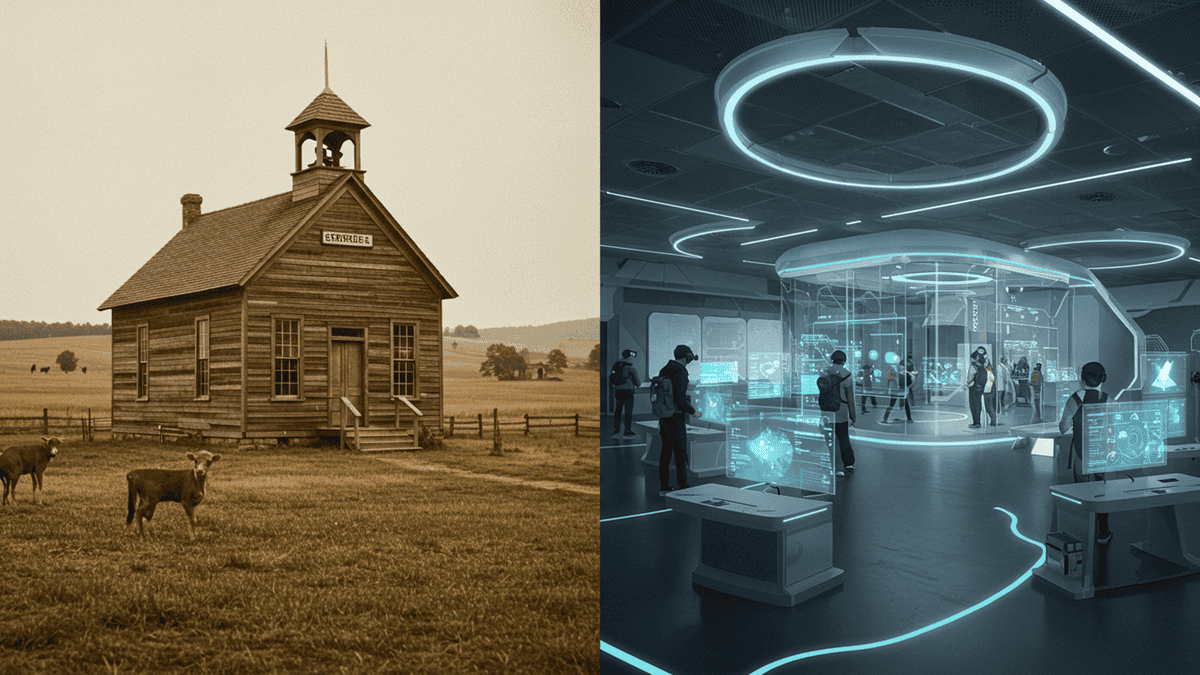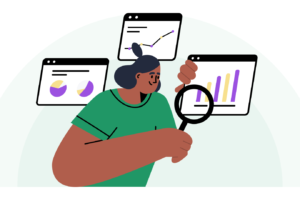
Real-World Transformation of Higher Education through Skills-Based and AI Literacy
Remote Learner.
On a scale of one to 10, where one is the worst word you can come up with to describe online learning in the education sector, aka EdTech, and 10 is where the word you should have used to describe it, education, and I’m looking at you, colleges and universities, scored a one.
When I heard the term, I thought to myself, “What?”
Is the CIA re-launching its remote viewing program?
It was a mitigated and bizarre thing to say, at the least.
I got the impression remote learning would be right up there – and it was and is.
This segment – Higher Ed, brought us Distance Learning, another awful term, where a bunch of students would be in a room, looking at other students and an instructor via a video cam.
Not what I would call effective learning.
Nothing screams boring than this offering.
EdTech continues to encounter challenges with AI
The whole cheating issue is front and center.
Ignoring for a moment that the “cheating” angle isn’t new – it existed when online learning first started back in the late 90s, and universities were heavily using Blackboard.
When a bunch of people have materials and books open and are taking a test online, what do you expect?
Companies were going into biometrics, which have mixed results – again, the whole books and materials thing.
Higher education, for all the smart people who work there, seems to be incapable of recognizing that AI is front and center and that kids, heck, even adult learners will use it for exams (why is this being used for online learning – ever heard of a project?), and papers.
Let’s ignore the fact of this thing called plagerism, which wasn’t a challenge to figure out that when a student’s vernacular doesn’t align to what they wrote – it is pretty evident with just a quick chat with them – or that they have endnotes so you wait for the book to be returned (back in the day) or do a search on the net (nowadays) to see if they wrote it, or if some scholar did.
The reality with AI and higher education, as well as corporate settings, is that it has the potential to revolutionize learning. It will be utilized, and it will be transformative.
Many AI experts believe that today, you can’t tell the difference between what is real, i.e., the students, and what is AI.
However, they are wrong.
First and foremost, higher education needs to urgently recognize that AI is here to stay and that students will be using it. The time for change is now.
Secondly, to change the approach, the professors, instructors, and anyone who teaches at a college or university should understand that deep thinking is something AI cannot do.
I repeat – deep thinking.
You want to change?
Ask questions that require deep thinking – you know, it gets the kids to use their brains based upon what is taught.
ChatGPT and other similar language models (LLMs) are unable to achieve this.
Thirdly, go for projects and not papers.
Align the projects to real-world scenarios, where you provide all the variables and situations.
This won’t eliminate cheating, but it will help the students to ascertain and come up with solutions.
Next, ditch the whole – I am assigning you a paper or some materials, or hey, let’s look at me via a web conference snooze fest.
Eliminate the whole synchronous-based learning, a mainstay in education, since cavepeople learned how to scribble animals on the walls of a cave.
SBL does not work.
It’s not about a discussion board or forum (welcome back to 1993); instead, it’s about using a syllabus for your remote learning experience, also known as online learning.
Corporate learning overwhelmingly uses asynchronous learning. Not SBL.
MOOCs failed because they went syllabus-ignoring, ignoring the reality that adults have lots of stuff to do, and the idea that a syllabus makes sense is ignorant of how online learning works.
What is the one constant with MOOCs and higher education learning?
A syllabus.
This is lockdown, step by step.
Who thinks this is an excellent idea, when people taking your courses can be anywhere in the world, at least in the country?
Who thinks that adult learners, a sizeable population of online learning in higher education, have the time to go through a syllabus with those wonderful due dates by professors, who in many cases put a time stamp on it, and if you do not get it in by time, too bad.
How many professors or instructors actually go into those discussion boards, review each document, project, or comment, and then leave their own comments?
Or what about those online office hours?
If you are a good professor or instructor offline, you will be online – unless you have never received training on how to use the learning system and all its nuances.
If you are awful, you still will be online.
What I have seen and heard from those who are teachers (primary and secondary) and faculty in higher ed is how crucial ongoing training is.
Yet, overall it is bad.
Responsibility for overseeing it by some faculty member, whether they are from a computer department or similar, at a location for a school or via the campus itself, is poor.
Now think about your audience – the faculty.
Have you ever developed a survey to see the level of technology, from using the internet to accessing programs such as PowerPoint and a PDF?
What is their confidence level with online learning?
And so on.
Suppose you honestly believe that your own faculty is not using AI in some form, at their home, campus office, mobile device, or even when reading those summaries on a web browser.
In that case, you are clearly looking for the golden ticket to see Willy Wonka.
It is mind-boggling how poorly, and I stress poorly in a negative sense, higher education is failing its students – those individuals who pay to attend their institutions.
Let’s not ignore the fact that higher education today is taking a beating.
So many politicos and similar – who believe they know more than the people on the front lines of teaching – see higher education as a fad.
An idea that has outweighed its usefulness.
The whole Ivory Tower is passe in their eyes – and I readily admit I have heard vendor executives think in the same way, on the lack of need for higher education, for the corporate world, especially with AI.
Here is how higher education can enhance its value and leverage
Generative AI in its operations.
It will not be easy.
It will require a different mindset (something that anyone who has taught at a university knows others who can’t seem to get out of their own way – with “change” being a word and not a constant belief and support.”
Hey Chancellor, President, or whoever oversees the institution
These are the steps you will need to take in Fall Semester 2026.
While I’d love to say this implementation can start in Spring 2026, the push of the wheel is a slog, and so cumbersome you would think that everyone is seeking an application to win the Nobel Prize in remote learning (did I mention this is an awful term?).
You do not have to go in order here – see – non syllabus approach – pick the steps you want to start with.
I’d recommend starting with business processes – plan – you heard me right. You need to think of the company as a whole, not just a higher education institution. (In all honesty, money drives higher education.)
Students are revenue numbers.
I know this because I was on a committee at the university where I taught, which made it quite clear that it is the core focus.
Step One
Hire someone to help you develop a business plan, including processes – and who knows first hand the online learning experience at a university (with an extensive background in business plans and processes, along with e-learning and learning tech (and for those in secondary – hire someone too, with experience in secondary, as a teacher, and extensive knowledge around online learning. (For Transparency purposes I offer services in these areas – and I can recommend another person who I rate as highly proficient)
Real World Examples – around the lack of a business process and plan
Back in the day, when I taught at a high school (and later at the university level), I was surprised by how many teachers lacked basic computer skills, including proficiency in specific programs and an understanding of online learning.
I observed the same phenomenon in the higher education setting.
And nobody seemed to care that the people responsible for teaching students online lacked the skills and understanding necessary to achieve success in this endeavor.
When I presented at Online Educa Berlin years ago, I asked how many attendees were using a third-party authoring tool compared to the one that comes with any EdTech platform.
Honestly, I was surprised at the number of hands raised.
This was great, but I wondered what the level of knowledge was and whether it was being applied to deliver success.
At another conference I spoke at, geared towards EdTech, I recall one professor mentioning that their college had blocked access to the internet when students were using the platform.
I asked her how they are stopping students from doing so in the dorms, at their homes, or on their mobile devices.
She stated that they, the university, couldn’t stop them.
Next, she noted that the students disliked the LMS, and usage was poor.
Digging deeper into the “dislike,” I learned that it wasn’t the LMS per se, but rather the content – specifically, the online courses being offered to them.
Who created those same courses?
Her response wasn’t new, I have heard it before, and even today, I know of companies whose learners hate using the system, and upon digging deeper, it is not the system that is the issue – it is the courses and content (including third-party, off-the-shelf).
What this said to me, as it relates to Edtech, is that the university had no idea how to implement the system, nor train their staff, nor any type of business plan, including processes.
Instead, they threw it out there, had their faculty use it, pushed it for their students, and then let it fail, blaming, no doubt, the vendor, ignoring that the university itself caused all this chaos.
Thus, business processes and a plan.
For online learning and AI
These processes must include the usage of AI at the university/college, including literacy and ongoing training for those teaching students, regardless of age.
AI Literacy, just as it is in the corporate setting, is the biggest issue we are facing in the industry.
Way too many misnomers, misinformation, and misunderstandings, with those in power, along with those using it, in this case, the faculty.
Step Two
Train. Train and train some more.
The individuals teaching these online courses need ongoing training.
This is two-fold.
a. Training on the premise and ongoing approaches with online learning. E-Learning isn’t still – it is systems thinking, rapidly changing due to other forms of learning technology, learning systems, methods (finally, at least corporate-wise), and the whole AI piece, which continues to be big.
b. Get the vendor off their seats and have them provide training on how to use their system, or learning tech. Not just once, but every quarter.
The learning system vendor should do this for free, and you will have that in the contract.
Offer a series of online learning walkthroughs (with your system) scheduled monthly, so that faculty members can sign up at a time that will work for them.
This is not a new concept for learning system vendors; it is simply something they dislike doing (or, to be more accurate, a lot of them).
Whomever is your administrator – have them learn the system inside and out.
When an issue arises, the faculty member contacts them, not the vendor.
The admin then performs a QA (Quality Assurance) to determine if the problem is due to the system or human error – the majority are due to human error.
If it is due to the system, the admin contacts the vendor’s customer support staff.
Add in the agreement that you want a dedicated customer/technical support member who knows you – i.e., your university/college, and how you are using the system.
Companies should do this too, but they never do.
Real World
It costs vendors a significant amount when the admin contacts them regarding a support issue.
A reduction in costs comes from the admin knowing the system.
Vendors often fail to provide a dedicated support person.
I know of vendors who offer concierge services (for free).
For whatever reason, they never mention it to their clients.
If you, the head of the university, would like a few workshops on-site, then the vendor should arrange them.
They will charge for it – that’s common.
A vendor’s goal is for you, the client, to love your system.
You will be a repeat buyer, a happy buyer, and probably will recommend the system to others.
Bonus
Be open to using a system that is not 100% focused on the edtech segment.
There are advantages for selecting a system on the corporate side, because they as a whole are more advanced in terms of where the market is going, and tapping into something you want – Skills.
There are plenty of vendors who are strong in skills management, and others who are not.
Realize that because a vendor is brand new to the industry or less than three years old, it doesn’t mean they have the latest or even understand the market.
It’s a trap I see way too often people fall into.
Some vendors target the EdTech and corporate markets.
In my experience, the best one to do this, and still tap into functionality you want, – think forward thinking is D2L (A top 10 learning system in 2024) – and one you can explore on FindAnLMS (FWIW).
Step Three
Change the Narrative – Skills. Skills. And more Skills.
You want your students to learn real-world skills.
Ditch theory-based.
If your students want that, they can read that worthless textbook, which most kids do not, or use ChatGPT, ignoring that any LLM will produce fake or false information (that is AI Literacy that way too many people are unaware of – even with sources).
I have always incorporated scenario-based learning into my online and in-class instruction for my students.
Students loved it.
They applied the knowledge they learned, tapping into skills they will use once they leave the college/university.
Why?
It’s real-world (i.e., real-life), skill-driven, and encourages deep thinking.
I even used scenario-based learning at the high school level.
The bonus there?
When the bell rang, they were still in class, working on the situation.
How many of your students will do that?
In both levels, I found that they scored higher on tests and pushed students who lack motivation to get involved (the enviable groups, where someone tells you that so-and-so isn’t showing up or doing anything).
Adult learners, I have found, love scenario-based learning.
Yet, even in the corporate setting, way too many folks overseeing L&D and Training fail to use it. What do they use instead?
Text, boredom, and more text.
I wonder if they experienced this at the university they attended with their learning platform, which the college had purchased.
Skills are why you read the whole push around ditching a university education, and learn the skills to do what you want.
The problem with this is that AI is going to wipe out some of those jobs, and that it isn’t just about skills, but re-skilling.
The primary skill companies are looking for these days is AI literacy.
I read it over and over again.
Therefore, one of those key skills must include AI literacy.
Mentor Me
Put together a mentor program.
This is where your faculty selects mentors (either at the institution who have the skill sets and expertise to listen, understand, and present beneficial information – not only as a coach, but as someone who can help in a personal and professional manner).
A secondary option is to find professors who are open and willing to connect with faculty at other universities who are also willing to mentor them.
A third option is to include folks in the corporate learning sector who can mentor them, too – I’d be willing to be such a person, and I know there are plenty of others who would stand up and say, “yeah, I’ll help them.”
Learn how to create course(s) and content students will use and love
Using a learning system – with usage that goes far beyond the assigned syllabus learning aspect (I wish folks would ditch this, but we are talking about folks who have never changed the way they have taught students, as in from the 1700s).
Usage will increase when there is a reason to do so.
Personal and Professional development courses must be included
I’m not talking about compliance here, I’m talking about skills that your students, including some adult learners, will need in the real world – once they leave college/university.
Courses should include
- How to apply to jobs online – look, folks are using ChatGPT here, and some companies are using AI for the recruiting and initial interviewing process.
- How to use ChatGPT or other LLMs with prompts that will provide the results relevant to them – this is a big problem even in the corporate setting. Vendors overall have a big F here.
- Technology Literacy on subjects they need to know and learn for the corporate setting
- Basic life situations – dealing with credit cards, how to not get into debt
- Real-world scenarios – Your faculty can create this, or you can find it online
- Content around skill development and skills – a novel concept – okay, I’m being snarky here.
- How to handle criticism – this is a big problem with the latest generation, and previous ones, too.
- Mental Well-Being – Huge in the higher education setting
Always look for fun courses, not some text-driven garbage. It’s boring and nobody likes it.
You want a significant change?
Universities think of themselves in a setting that is no longer fully applicable.
What they fail to see is that, as a whole, they need to be run like a business.
Students are your employees – new – onboarding, been there – on-going.
Your faculty members are managers and department heads – and they themselves need ongoing learning and training too.
Chancellor. President?
They are the CEO(s).
Biggest impact?
Cost – which creates a problem for those who wish to achieve a degree, so I am going to push an idea.
A collaborative university experience, three options.
Option A
Your university aligns with other colleges/universities, whereas the student can apply to one, and get access to all – 100% online – towards a degree.
They take the courses they need and are required to take.
You eliminate those GEs that everyone hates, and instead zero in on skills development and skills they need for their job role or whatever job they are seeking.
If they plan to attend graduate school, they still need to develop skills in their core focus.
Getting back to the undergraduate degree, the institution where they completed the most courses/content is the one from which their degree comes. It may not be your university; it could be XTA.
For practical experience, such as nursing, they learn practical skills via XR and AI, and then apply them on-site, as they would typically do.
The application process has changed because the students are going 100% online.
The cost should be lower than if they go on-site to the college/university and the usual application process.
Option B
Your university teams up with the local community college or colleges.
The latter become feeder programs to your university.
If a student prefers the CC route, they can also take courses/content at your university and begin working on their degree.
This would be 100% online.
There can be numerous universities that tie with a CC and vice versa.
Option C
University ties into a company or a few companies.
The university/college becomes a feeder into the company/companies
A ready and hungry workforce is now established – with opportunities presented in the learning platform, based on skills and content tied to one another.
Opportunities do exist in some learning systems.
You can combine the CC, university/college, with the company and companies.
You are not limited to one location, but many.
Bottom Line
All the above in this post include two-year higher education places, along with four-year places.
If you have an internship program, tie into a company or companies that have a strong track record for onboarding and development.
Apprenticeship?
A workforce already set with the tie-in approach.
Degrees – become skill-driven, tied into content that is presented in a real-world/real-life scenario.
Adaptive learning, Knowledge Management, and AI literacy all play a crucial role.
Forward-thinking systems are your goal.
Train. Train. Train your faculty.
Embody a new approach to learning.
Not one stuck in yesteryear
Rather one that
is driven by the new way to deliver success
Skills-focused, AI Literacy, and a mindset
of a Business
Not a stodgy school of the past.
E-Learning 24/7
Source link



